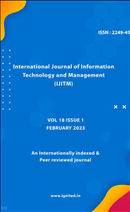A Review the history of Indian Banking Sector of Changing Income Configuration
Main Article Content
Authors
Abstract
Indian banking has evolved from a traditional structure to a modern, technology-driven enterprise. The paper explores how policy changes, financial inclusion initiatives, and technological advancements have influenced banks' profitability and sustainability. Financial institutions are money traders because they deal with money. However, banks' roles have grown and evolved over the years. Thus, banks are increasingly involved in the creation of credit in addition to their traditional role as money exchangers. The Indian banking system has made great strides & accomplished remarkable things in recent years. Indian banking has expanded to even the most remote regions of the country, showcasing its wide-ranging influence and inclusive economic story. When it comes to India's financial system, banks are the big players. Banking companies in the current day enhance people's quality of life by providing a wide range of services & facilities to its clients. By analyzing these trends, the review provides insights into the dynamic nature of income generation in the Indian banking sector and its implications for future growth.
Downloads
Article Details
Section
References
- Alam, M. S., Rabbani, M. R., Tausif, M. R., & Abey, J. (2021). Banks’ performance and economic growth in India: A panel cointegration analysis. Economies, 9(1), 38.
- Bhandari, M. (2012). “A comparative financial performance analysis of Himalayan bank Ltd. And Everest bank Ltd”. A Ph.D. Thesis. Department of Management, Tribhuvan University. Nepal
- Chandan, C., & Rajput, P. K. (2002). Profitability analysis of banks in India: A multiple regression approach. Indian Management Studies Journal, 6(1), 119– 129.
- Desai, D. S. (2013). Performance Evaluation of Indian Banking Analysis. International Journal of Research in Humanities and Social Sciences, 1(6), 30-36.
- Gadhia, M (2015). “The study on financial performance of selected public and private sector banks in India with reference to CAMEL Model”. A Ph.D. Thesis. Department of Commerce, Saurashtra University. Rajkot. Indian Central Banking Enquiry Committee report (1931). Vol-1.
- Ibrahim, M. (2015). “A comparative study of financial performance between Conventional and Islamic banks in United Arab Emirates”. International Journal of Economics and Financials Issues. 5 (4).pp. 868-874.
- Joshi, P. V., & Bhalerao, J. (2011). Efficiency evaluation of banking sector in India based on data envelopment analysis. Indian Journal of Commerce & Management Studies ISSN, 2229, 5674.
- Ketkar, K. W., Noulas, A. G., & Agarwal, M. M. (2003). An analysis of efficiency and productivity growth of the Indian banking sector. Finance India, 17(2), 511.
- Maiti, A., & Jana, S. (2017). Determinants of Profitability of Banks in India: A Panel Data Analysis. Scholars Journal of Economics, Business and Management (SJEBM), 4, 436–445.
- Mohan, T. R., & Ray, S. C. (2004). Comparing performance of public and private sector banks: A revenue maximisation efficiency approach. Economic and Political Weekly, 1271–1276.
- Rajput, N., & Gupta, M. (2011a). Efficiency of public sector banks operating in India: Post-reforms period analysis. Afro-Asian Journal of Finance and Accounting, 2(4), 349–368.
- Sharma, E. (2011). “A study on performance of Indian commercial banks and its relationship with human aspects in banking”. A Ph.D. Thesis. Department of Humanities and Social Science. Jaypee Institute of Information Technology, Noida.

